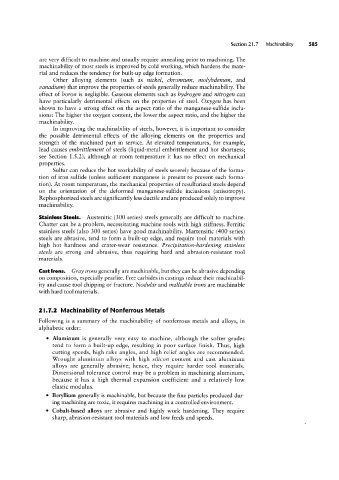Page 604 - 04. Subyek Engineering Materials - Manufacturing, Engineering and Technology SI 6th Edition - Serope Kalpakjian, Stephen Schmid (2009)
P. 604
Section 21 7 Machmability
are very difficult to machine and usually require annealing prior to machining. The
machinability of most steels is improved by cold working, which hardens the mate-
rial and reduces the tendency for built-up edge formation.
Other alloying elements (such as nickel, chromium, molybdenum, and
vanadium) that improve the properties of steels generally reduce machinability. The
effect of boron is negligible. Gaseous elements such as hydrogen and nitrogen can
have particularly detrimental effects on the properties of steel. Oxygen has been
shown to have a strong effect on the aspect ratio of the manganese-sulfide inclu-
sions: The higher the oxygen content, the lower the aspect ratio, and the higher the
machinability.
In improving the machinability of steels, however, it is important to consider
the possible detrimental effects of the alloying elements on the properties and
strength of the machined part in service. At elevated temperatures, for example,
lead causes embrittlement of steels (liquid-metal embrittlement and hot shortness;
see Section 1.5.2), although at room temperature it has no effect on mechanical
properties.
Sulfur can reduce the hot workability of steels severely because of the forma-
tion of iron sulfide (unless sufficient manganese is present to prevent such forma-
tion). At room temperature, the mechanical properties of resulfurized steels depend
on the orientation of the deformed manganese-sulfide inclusions (anisotropy).
Rephosphorized steels are significantly less ductile and are produced solely to improve
machinability.
Stainless Steels. Austenitic (300 series) steels generally are difficult to machine.
Chatter can be a problem, necessitating machine tools with high stiffness. Ferritic
stainless steels (also 300 series) have good machinability. Martensitic (400 series)
steels are abrasive, tend to form a built-up edge, and require tool materials with
high hot hardness and crater-wear resistance. Precipitation-hardening stainless
steels are strong and abrasive, thus requiring hard and abrasion-resistant tool
materials.
Cast Irons. Gray irons generally are machinable, but they can be abrasive depending
on composition, especially pearlite. Free carbides in castings reduce their machinabil-
ity and cause tool chipping or fracture. Nodular and malleable irons are machinable
with hard tool materials.
2l.1.2 Machinability of Nonferrous Metals
Following is a summary of the machinability of nonferrous metals and alloys, in
alphabetic order:
° Aluminum is generally very easy to machine, although the softer grades
tend to form a built-up edge, resulting in poor surface finish. Thus, high
cutting speeds, high rake angles, and high relief angles are recommended.
Wrought aluminum alloys with high silicon content and cast aluminum
alloys are generally abrasive; hence, they require harder tool materials.
Dimensional tolerance control may be a problem in machining aluminum,
because it has a high thermal expansion coefficient and a relatively low
elastic modulus.
° Beryllium generally is machinable, but because the fine particles produced dur-
ing machining are toxic, it requires machining in a controlled environment.
° Cobalt-based alloys are abrasive and highly work hardening. They require
sharp, abrasion-resistant tool materials and low feeds and speeds.

